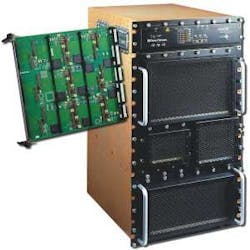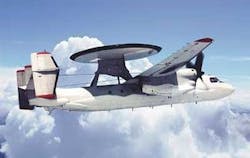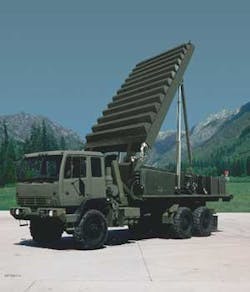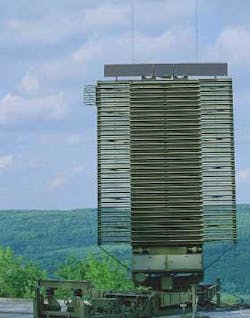Radar processing shifts to FPGAs and Altivec
Long the exclusive domain of digital signal processors, today's radar systems designers rely more heavily than ever before on a combination of field programmable gate arrays and the Motorola PowerPC Altivec general-purpose processor for their computational needs.
By John Keller
Until recently, most complex radar signal-processing applications fell under the exclusive domain of the dedicated digital signal processor (DSP). These expensive and powerful DSP devices were virtually without peer when it came to the fast, complex, and repetitive kinds of data processing necessary to massage large streams of radar data in real time.
Yet many systems designers say that dedicated DSPs from companies such as Analog Devices in Norwood, Mass., and Texas Instruments in Sherman, Texas, may have run their course for most new radar-processing architectures, and remain dominant only in relatively old so-called "legacy" radar systems. The DSP retains its dominance in legacy radar systems so that designers can avoid major software rewrites during system upgrades.
Instead, radar experts today increasingly are looking to a combination of field-programmable gate arrays (FPGAs) and powerful general-purpose processors such as the Motorola PowerPC Altivec to handle processing loads that until recently many thought only DSPs could tackle.
The FPGAs, although they are expensive and difficult to program, are unparalled today in their efficiency to perform extremely fast, complex, repetitive computing tasks that are ideally suited for "front-end" radar signal processing that prepares digital signals for efficient handoff to relatively inexpensive general-purpose processors for the so-called "back-end" radar processing.
"In smaller radars such as airborne — those in pods or in the nose of jets, and also on UAVs — the trend is away from dedicated signal processing chips, and toward general-purpose chips like the Altivec," says Philip Lindsay, northeast regional sales manager for Thales Computers Inc. in Raleigh, N.C. UAVs stands for unmanned aerial vehicles.
Radar complexity
Radar — an old acronym for radio detection and ranging — has always been a demanding technology, but at no time more so than today. Essentially, it works by emitting radio frequency (RF) signals at particular frequencies, and then listening for the signal's return — or "bounce" — off of targets of interest. At it simplest theoretical level, this does not sound like a big deal, but putting the theory into useful practice is where advanced technology — and designers headaches — come in.
Several different kinds of radar systems are in use today, including continuous wave (CW), pulsed, pulsed-Doppler, phased array, and synthetic aperture.
null
CW radar continually transmits energy toward the desired target and receives a reflection of this "continuous wave." These kinds of radar are useful for determining a target's velocity by using the Doppler effect to compare differences in the transmitted and received signals. These radar systems, however, have difficulty determining the target's range, or how far way it is.
Pulsed radar, on the other hand, sends out a series of short RF pulses. By measuring how long it takes to receive the returns from these pulses, system operators can estimate the range to the target. Pulse Doppler radar, in addition, uses Doppler shifts with radar pulses to determine the velocities of moving targets. These systems can determine the velocities, angles, and ranges of targets. These added capabilities, however, make pulse Doppler radar much more compute-intensive than simple pulsed radar.
Phased array radar systems, meanwhile, arrange large numbers of transceiver modules arranged on flat or curved surface. The system controls the phase — or a slight variation in the transmit and receive time of groups of transceiver modules — with computer commands, and in essence "steers" the radar beams quickly, enabling the phased array radar to scan specific areas quickly, "stare" at targets of interest, or do a variety of other tasks, all without the need to move the transceiver array mechanically.
The ability of phased array radar systems to manipulate their groups of transceivers also gives this system an "adaptive array" capability, which not only can steer beams quickly, but also enables the system to shift the focus of radar beams to "null out" electronic interference or jamming.
Precise radar images most often come from synthetic aperture radar systems. These so-called "side-looking" aircraft-mounted systems — such as the U.S. Joint Surveillance and Target Attack Radar System known as Joint STARS — produce two-dimensional images, where one dimension is the range, or distance from the radar to the target using Doppler processing, and the other dimension is the azimuth, which requires a physically large antenna to focus the transmitted and received RF signal into a sharp beam. Synthetic aperture radar, better known as SAR — collects data over a long distance, and processes the data as if it came from a physically long antenna. SAR requires extremely fast processing and very fast signal sampling rates.
After all this, the way in which a radar system processes information also can change the nature of the radar system itself. Take radar pulse compression, for example. This is a technique that makes the most of the radar's sensitivity and resolution by balancing the effects of radar pulse duration, radar pulse power, and radar pulse bandwidth.
Pulse compression uses Fast Fourier Transform (FFT) processing to massage the signal as it comes in from the A-D converters. "With pulse compression, you need to take an FFT of the radar signal to remove as much stuff that doesn't belong to the return signals as possible," explains Rodger Hosking, vice president of Pentek Inc. of Upper Saddle River, N.J., which supplies single-board processors to radar designers.
"So they send out a 'chirp', or a unique signal that doesn't exist in nature," Hosking continues. "You convert what comes back into frequency domain, and take the frequency domain of your outgoing pulse and correlate the two. You extract only the part of the signal coming back that has to do with the outgoing pulse. Then you do an inverse FFT, and you get a very nice 'blip'." Until recently, Hosking explains, that kind of processing has been done in analog, and in DSPs. "It's a very demanding problem to do in real time."
Processing challenges
One of the first and most serious problems confronting radar systems involves noise and clutter in the return signal. After all, RF energy bounces off a lot more than simply the target of interest; it bounces off trees, buildings, mountains, vehicles, and about anything else in its path, and in various degrees of intensity depending on the reflecting materials.
One of the most important tasks of modern radar systems is to reject, or "filter-out," return signals that are not of interest. Next, radar users today want far more from their systems than simply the proverbial "blip on the screen." Many modern radar systems are able to filter their return signals so finely that these signals produce an actual image of the target. Finally, most radar systems — particularly those for military and aerospace applications — must operate in real time. All these factors combine to produce a challenge of staggering computational intensity for all but the simplest radar systems.
Today's radar systems digitize their signals very quickly after receiving them. After analog-to-digital conversion, advanced algorithms process the signals to eliminate noise by filtering out unwanted portions of the signal, perform Doppler calculations to help determine range, and do many other operations to prepare the data for further processing later that will do tasks like enter radar signatures into databases and display the information on graphical screens.
In the front-end "pre-processing" stage, the processor of choice increasingly is the field programmable gate array (FPGA) from companies such as Xilinx Inc. in San Jose, Calif., and Actel Corp. in Sunnyvale, Calif. This is primarily a move away from DSPs on the front end, experts say. At the same time, systems designers rely more heavily than ever before on high-end general-purpose processors such as the Altivec on the back end.
The rise of FPGAs
FPGAs only recently have achieved the kinds of densities necessary for fast and demanding radar front-end processing, experts say. "FPGAs are now so much bigger and so much faster than they were years ago," says Jane Donaldson, president and chief executive officer of Annapolis Micro Systems Inc. a radar processing firm in Annapolis, Md. "Normally you can have 30 million gates in a single VME slot, while five years ago you would struggle to get a million gates. You have enough processing power now to solve the problem."
This fast expansion in number of gates per device has made all the difference for radar systems integrators and their signal processing systems providers. "Over the past year we have been seeing a swing to more FPGA processing, particularly at the front end of radar and sonar processing, for repetitive math functions, filtering, and things that go on at the front end of the processor," says Stuart Heptonstall, product marketing manager for DSP products at Radstone Technology, a single-board radar processor supplier in Towcester, England. "FPGAs you can code exactly how you want, to keep them chunking away at that front-end data," he says, and enable designers to change the front-end processor for different platforms.
null
"Our customers, the prime contractors, all are looking to put FPGAs as close to the radar sensing elements as possible — the antennas, transmitters, and receivers — to do pre-processing," says Philip Lindsay, northeast regional sales manager at Thales Computers Inc. in Raleigh, N.C. FPGAs, he says, are valuable for "massaging the data and lining it up so it is amenable to quick-corner turns, or quick FFTs, or quick FIRs [finite responses] so it can be processed almost immediately by the CPUs. They get the data as they need it, and you reduce latency."
The radar signal-processing challenge is not fundamentally different today from how it was decades ago; what is changed is the processing approaches, which is where FPGAs come in today, says Larry Nork, director of radar business development at Mercury Computer Systems in Chelmsford, Mass.
The Lockheed Martin Medium Extended Air Defense System (MEADS) uses a UHF surveillance radar and X-band Multifunction Fire Control Radar.
"In radar signal processing. What you needed in the past you need today, but you might do it more efficiently today," Nork explains. "You take channel equalization, phase compensation, and follow that up with pulse compression done with convolution processing where you have an FFT and a complex multiply, then do a inverse FFT, and that allows you to match filter processing on the radar return. Those are data-independent functions that are performed in a streaming fashion no mater what is coming into the input of the radar receiver, where the same function is repeated time after time, with no need for programmability. So you can add efficiency to the processing by using FPGAs, as opposed to using a programmable RISC processor."
Still, Radstone's Heptonstall cautions that the necessary investment in FPGAs is relatively high, and implementers also must invest a lot of time providing the FPGA function. The FPGA programmer must write his own VHDL FFT code to engineer that solution, while today's DSPs often are easier to program than are FPGAs.
Many systems designers insist that DSPs still have a role in radar processing; the trick is to determine the niche that FPGAs and DSP processors serve, says Bernard Pelon, director of product research at CSPI Inc., a radar processing supplier in Billerica, Mass. Either the FPGA or DSP might do better on some classes of problems, but might be more difficult to use, he says. "That may be why we begin to look at FPGAs and specialized processors. We need to understand where each applies and balance them out."
No matter the choice of the FPGA or DSP, Pelon points out that both represent a step away from trends toward general-purpose processors that are not application specific, although he says FPGAs are farther away from the general-purpose ideal than are today's DSPs. "In both cases you lose generality; there is no question that they are not general-purpose hardware," he says. "What we are facing is a non-standard world. The FPGA inside is a profusion of non-standard things, such as how you connect your gates, so with the specialized DSP there is an advantage. Now we need to define a standard internal FPGA bus, and we are nowhere close to that."
As far as CSPI is concerned, "we lean to FPGA and specialized DSP; there is space for both, Pelon says. They are both in the spatial function side." He points to new generations of DSPs, such as the Analog Devices TigerSHARC, and the FastMATH and FastMIPS architectures from Intrinsity Inc. in Austin, Texas, that might cause radar designers to take another look at DSPs — either for front- or back-end processing.
The PowerPC Altivec
On back-end radar processing, meanwhile, "two to three years ago we started seeing a shift away from dedicated DSP chips over to the PowerPC processors," Heptonstall says. The DSP chips required coding in low-level languages, such as assembler, "which is great if you know how to do it, and have the time, but we need to get to market quicker today," he says. "It's too much of a pain and an investment to program in assembler all the time."
Rapid increases in the PowerPC Altivec's clock speed and other performance parameters started gaining the attention of radar systems integrators about three years ago when Motorola first introduced the Altivec version of the venerable PowerPC microprocessor, CSPI's Pelon says.
"Before Altivec, PowerPC was not judged to be very attractive, but after Altivec it was judged to be a very good solution," Pelon says. It was significant because you were bringing DSP into a scalar architecture. You increased by a factor of four the operations you could run. It was fantastic news for anyone who had chosen the PowerPC architecture."
Six years ago, for example, the most advanced PowerPC processors ran at clock speeds of 200 MHz, "but then, with the Altivec, you had 400 MHz — four times the operations, plus the processor's L2 cache was improved. So overall you had a factor of 20 improvement for FFT processing" Pelon says. PowerPC Altivec processors soon will be available that run at clock speeds as fast as 1 GHz.
Software issues also make up an attractive aspect of general-purpose processors such as the Altivec, experts say. Radstone's Heptonstall says he believes the Motorola suite of advanced PowerPC Altivec processors "have much more easy user interfaces and support for off-the-shelf real-time operating systems such as Wind River VX Works, Linux, LynuxWorks LynxOS, and the OSE real-time operating system," than do the industry's DSP offerings. "The processors have a lot of momentum for these operating systems and have commonality with slot-1 single-board computers, which are predominantly the PowerPC processor. It makes the whole thing easier and more user friendly," he says.
Aside from its advantages in speed, the PowerPC Altivec also offers designers the benefits of a standard off-the-shelf architecture that is well understood throughout the industry. "The benefit of standard hardware and software is concurrent engineering," says CSPI's Pelon. "If I have a piece of software that you can run on any workstation, then you can have several players doing concurrent engineering, and that couldn't be done in the past. That translates into minimizing development time, which is very important in terms of effective results and solutions and quality."
Another factor running in the Altivec's favor is the new crop of fast switched-network architectures, such as RapidIO, Infiniband, and StarFabric, which promise to boost the Altivec's power when many processors combine on a network. In terms of fabric, none of this can work without a very fast fabric to connect general-purpose processor nodes with some of the more specialized nodes," Pelon says. "We need more than ever a high-speed interconnect."
Architectural considerations
Often the type of radar system under development will help determine the signal-processing architecture. Large fixed-site radar systems with virtually unlimited capacity for space, weight, and power, for example, might accommodate a processing architecture heavy on general-purpose processors. Yet fighter aircraft radar, which places a premium on small size, lightweight, and low power consumption, might require a processor architecture heavy on FPGA and DSPs, and might not accommodate general-purpose processors at all.
"The requirements for small-volume and low weight in advanced applications rely heavily on FPGAs. Other areas where we are not as restricted is where we can use the off-the-shelf processors," explains Kam Insky, manager of radar engineering project management at Lockheed Martin Naval Electronics & Surveillance Systems in Syracuse, N.Y. Lockheed Martin Syracuse provides a wide variety of radar systems, from large ground-based air traffic control systems, to space-constrained airborne systems.
null
"In our advanced ground and airborne systems, where we not only deal with volume and weight, but also in advanced technologies such as digital advanced beamforming, we use a hybrid — or FPGA — approach, primarily on the front end," Insky explains. "For backend data processing, we use general-purpose processors" such as the PowerPC.
"There are niches," Insky points out. "I see an evolution to more use of FPGAs than the dedicated DSPs, but we still have a product that relies heavily on DSPs" — an airborne system that uses the Analog Devices SHARC, he says. It is primarily driven by application — and in our applications now, we see continued use of FPGAs."
Popularity of the Altivec helps designers re-invent the DSP
Although some radar systems designers may be writing off the digital signal processor (DSP) as a thing of the past in radar processing systems, proponents of the DSP say word of their passing is premature.
The recently released TigerSHARC DSP from Analog Devices in Norwood, Mass., is perhaps the strongest argument against the demise of the DSP in radar applications. Yet the TigerSHARC and other new DSPs are competing head-to-head with the PowerPC Altivec microprocessor, not field programmable gate arrays (FPGAs), in radar applications, experts say.
The TigerSHARC is an ultra high-performance static superscalar architecture for computationally demanding applications, and combines elements of RISC, VLIW, and standard DSP processors for 1-, 8-, 16-, and 32-bit fixed and floating-point processing.
The original Analog Devices SHARC 21060 DSP — short for Super Harvard Architecture — dominated radar and sonar signal processing applications throughout the 1990s, yet gradually gave way to fast Altivec processors as the new century dawned.
DSP proponents say the new TigerSHARC will give a big boost not only to the Analog Devices DSP product line, but also to DSP architectures across the board.
"We've seen with the introduction of the TigerSHARC, our competitive environment changed 180 degrees; historically when we introduced the SHARC, we competed with Texas Instruments [DSPs}. Now with the introduction of the TigerSHARC, we are competing with the Altivec," says Darren Taylor, vice president of sales and marketing at BittWare Inc., a single-board DSP designer in Concord, N.H.
"The TigerSHARC serves very well in some of these radar applications; we are seeing it across the board for radar systems," particularly for air traffic control, over-the-horizon, and 3D-based radar applications, Taylor says.
The European radar manufacturer Alenia Marconi, for example, is using the TigerSHARC as their processor of choice for next-generation 3D air traffic control radar systems, Taylor says. "They did this because of the ability to do the continuous data movement and processing."
Taylor admits that the Altivec G4 general-purpose processor can crunch data faster than the TigerSHARC can, "but you need to get the data in and the data out," he says. "That is where the TigerSHARC does much better in the real world."
In addition, Taylor says, the TigerSHARC is more attractive in terms of power consumption. "The G4s are huge consumers of power" from five to 20 watts per chip, he says. "You are limited to the number of processors you can get on a board."




